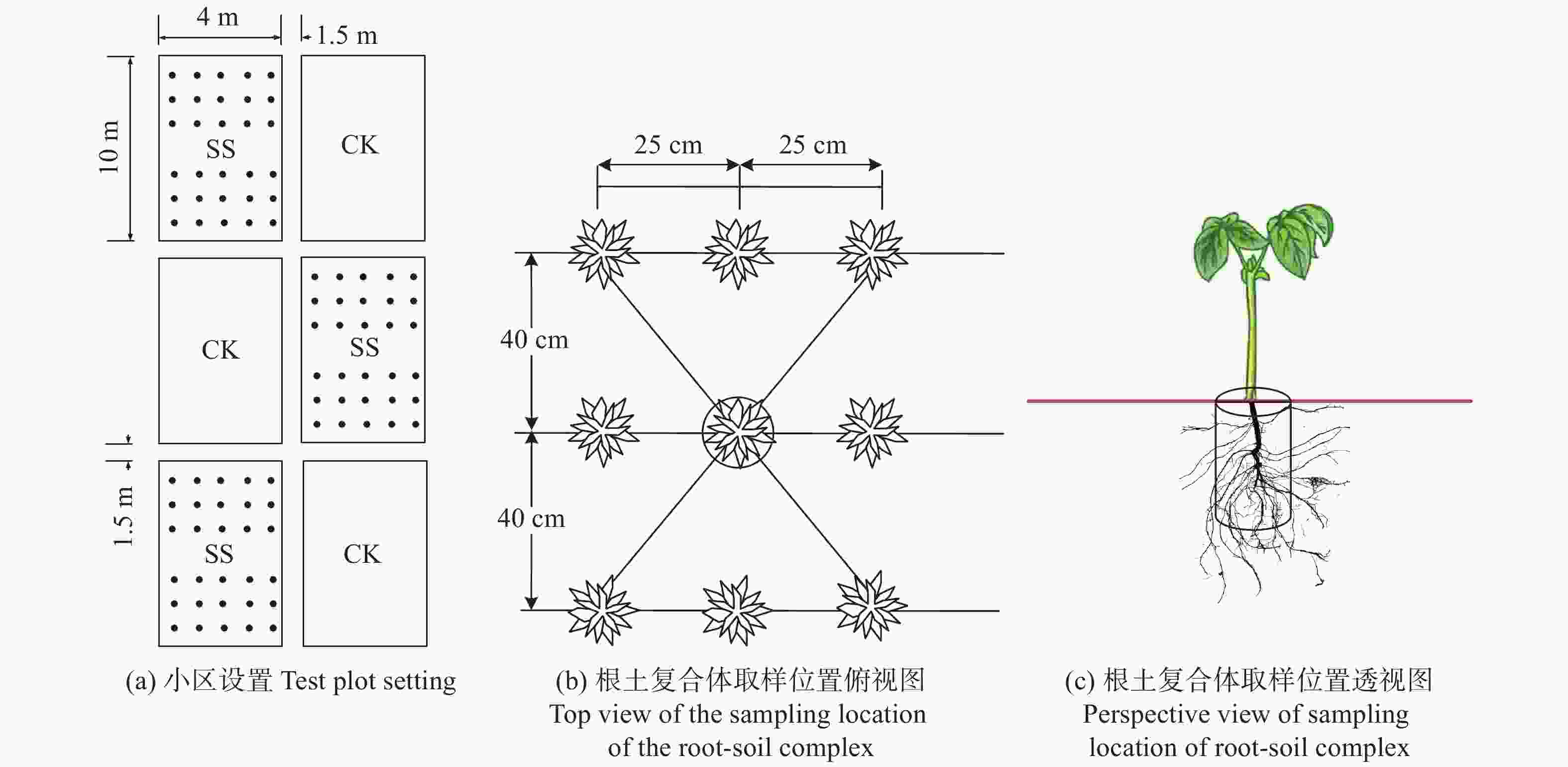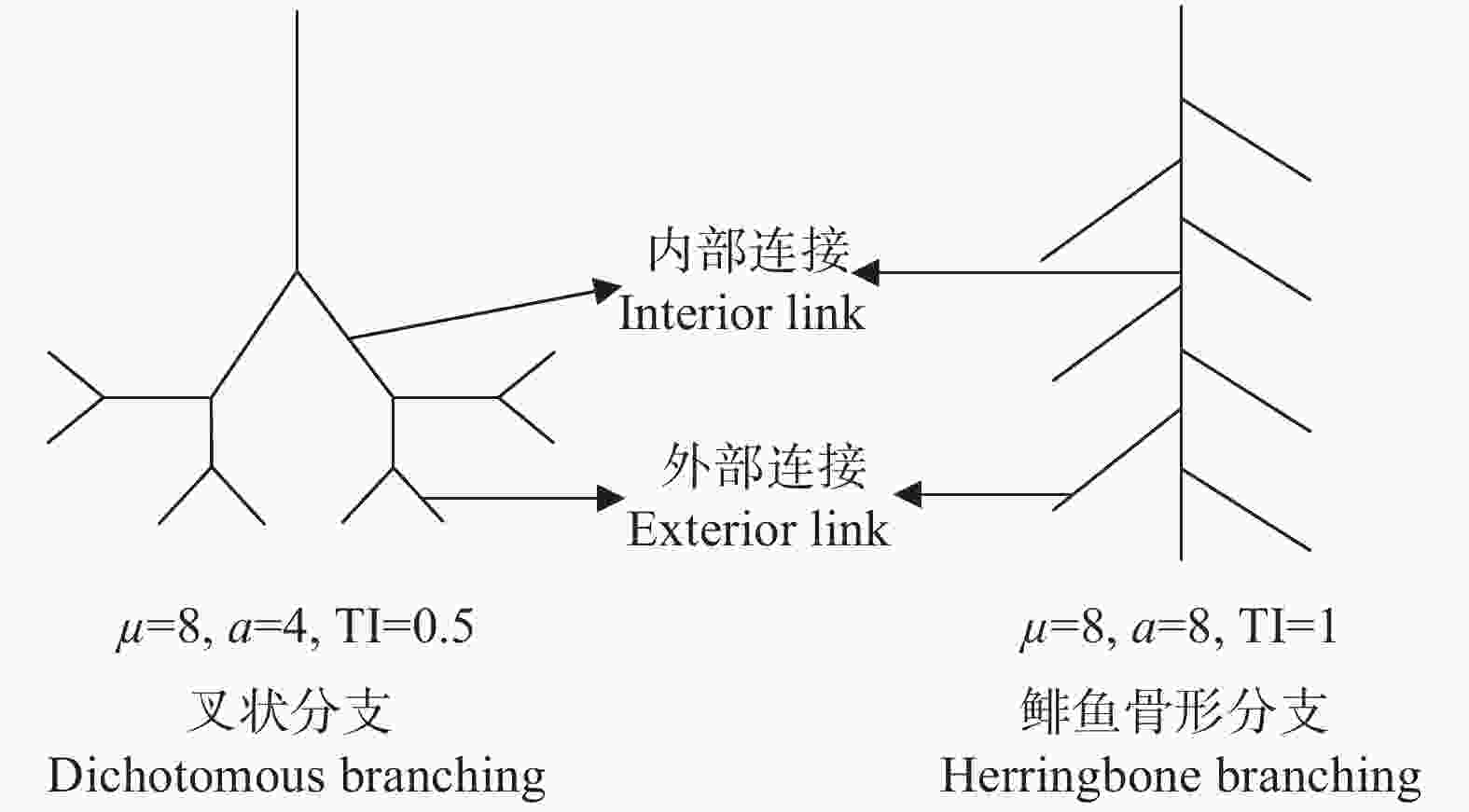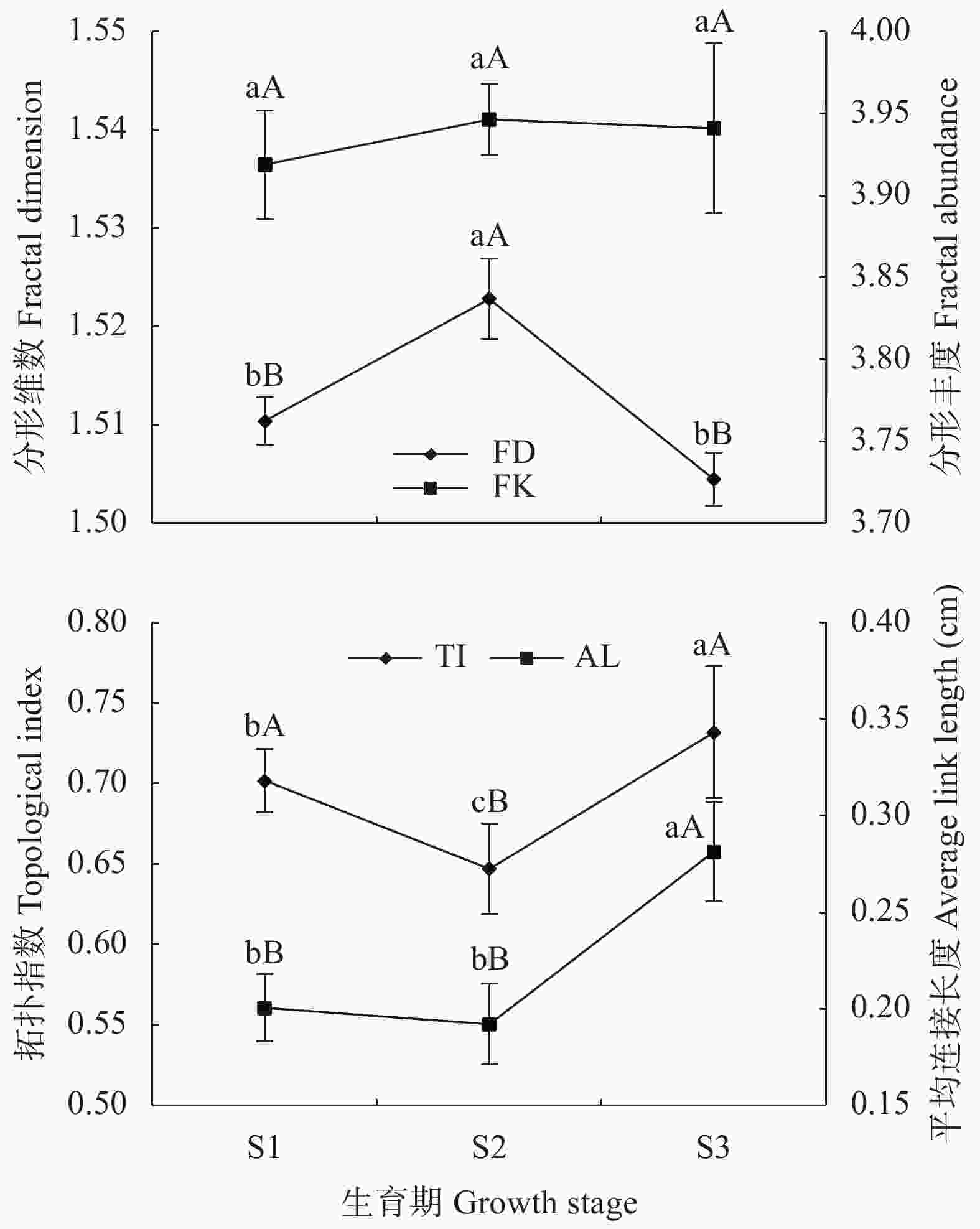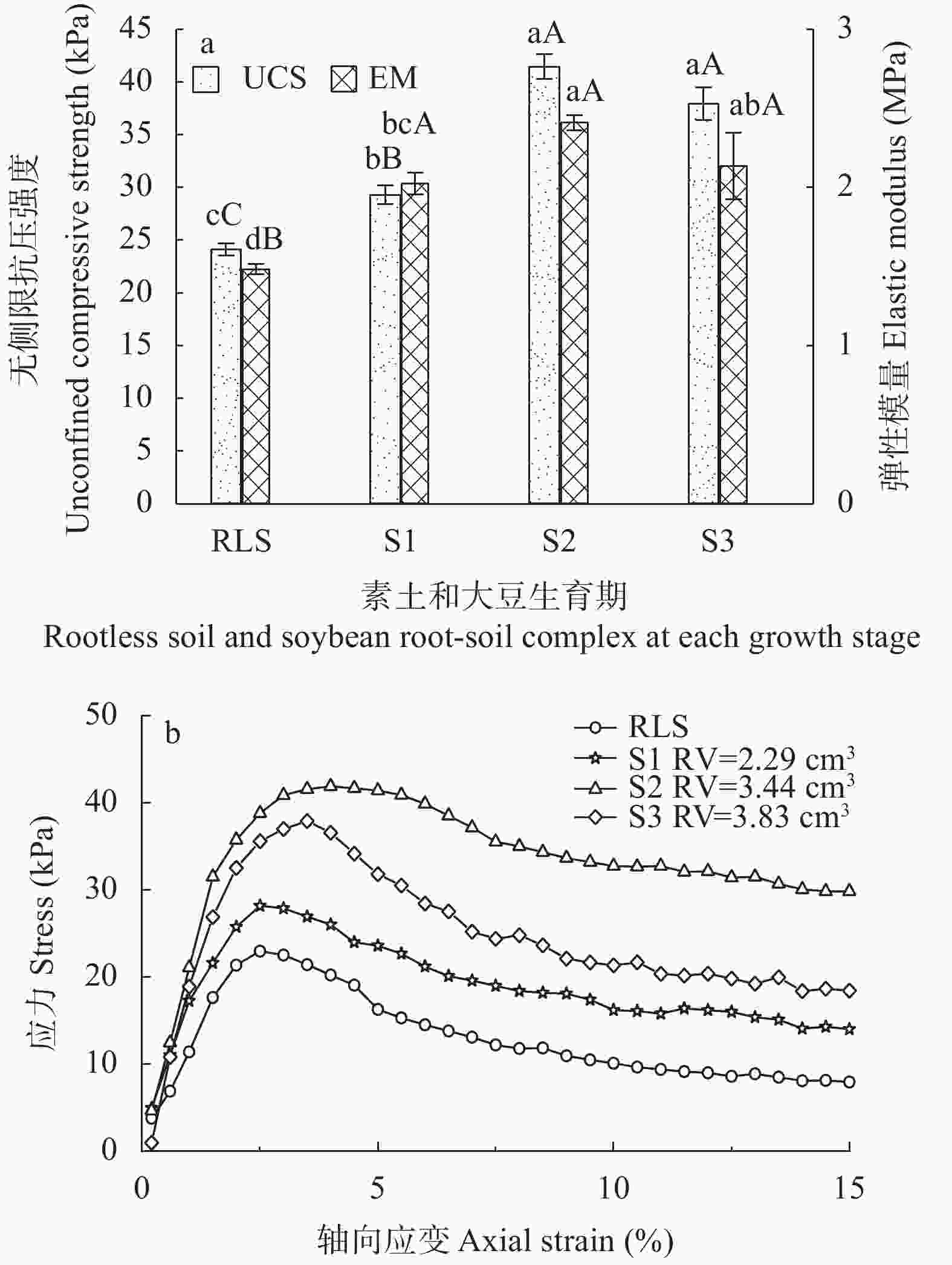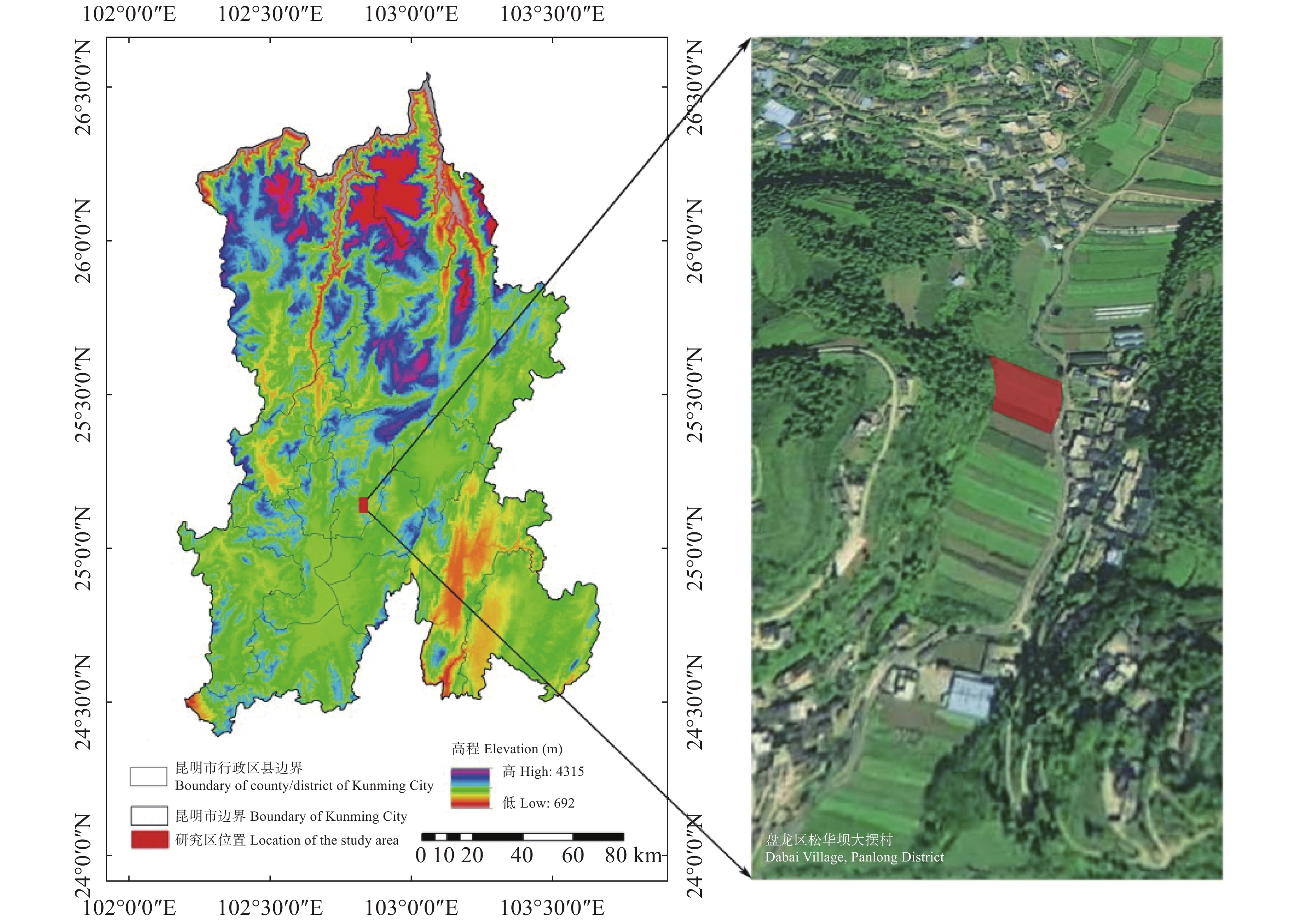Soybean roots architecture and the mechanical properties of the root-soil complex in mountain red soil on sloping farmland
-
摘要: 为研究大豆根系在西南山区坡耕地水土保持中的价值, 本文在大豆的3个主要生育期(开花期、始粒期和鼓粒期)采集根系和根土复合体样本, 采用WinRHIZO (Pro.2019)根系分析系统测定并计算了根系的几何形态特征、分形特征和拓扑结构, 用无侧限压缩试验测定了根土复合体的力学特性, 分析大豆根系在不同生育期的构型特征及其对土体力学特性的影响。结果表明: 1)大豆根系的分形维数在鼓粒期最小, 分形丰度在开花期最小, 但两者均在始粒期最大; 2)拓扑指数随生育期先减小后增大, 在始粒期最接近0.5, 且平均连接长度最小, 根系趋向于叉状分支模式, 此时根系分支状态最为复杂; 3)大豆根系的分形特征、拓扑特征与根长等主要形态特征参数有极显著相关关系(P<0.01); 4)大豆根系能显著增强土体强度, 其根土复合体的无侧限抗压强度表现为始粒期(41.44 kPa)>鼓粒期(37.95 kPa)>开花期(29.29 kPa), 分形维数和分形丰度与土体的力学特性呈显著正相关关系(P<0.01)。综上, 大豆根系分形维数和丰度越大、拓扑指数越小时, 根土复合体的无侧限抗压强度越大, 其根系固土效应越显著; 农作物根系分形特征和拓扑特征不仅可用于表达根系在土体中的分支状态、空间分布和拓展模式, 也可作为评价农作物根系固土效应的主要参数。在山区坡耕地的农作物配置中, 应注重培育分支复杂、根系发达的大豆品种以防治水土流失。Abstract: The sloping farmland area in Yunnan accounts for 70% of the total arable land area, and its sustainability is affected by severe soil erosion. Approximately 89.4% of the sloping farmland in the province is utilized for planting crops, and soybeans are one of the main crops in summer. Previous studies have shown that the soil fixing capacity of vegetation roots plays a significant role in soil and water conservation. This study was conducted to explore the soil-fixing capacity of soybean roots and to provide a basis for the calculation of the soil-fixing ability of crop roots. Thus, a field experiment was designed to have two treatments with three replications for a total of six plots: bare land (CK) and mono-soybean field (SS). Unconfined compression tests were used to determine the shear strength and stress-strain characteristics of rootless soil and root-soil complexes during the three main growth stages of soybeans (blooming stage, initial grain forming stage, and seed filling stage). The WinRHIZO (Pro.2019) system was employed to analyze the geometric characteristics, fractal characteristics, and topological structure of the roots. The structural characteristics of soybean roots at different growth stages and their effects on soil mechanical properties were analyzed. The results indicated that:1) the fractal dimension of soybean roots was the smallest at the seed filling stage, and the fractal abundance was the smallest at the blooming stage, while both were the largest at the initial grain forming stage. 2) The topological index of soybean roots was the largest at the seed filling stage, followed by the blooming stage, and was the smallest at the initial grain forming stage, when it was approximately 0.5, with the smallest average link length, suggesting that the soybean roots tended to have a dichotomous topology pattern and reached the most complicated branching status at the initial grain forming stage. 3) The fractal characteristics of soybean roots were significantly and positively correlated with the main morphological parameters, such as root length (P<0.01), while the topological characteristics were significantly and negatively correlated with them (P<0.01). 4) Compared with rootless soil, soybean roots could significantly enhance the strength of root-soil complexes. The unconfined compressive strength of the soybean root-soil complexes was the highest at the initial grain forming stage, followed by the seed filling stage, and was the lowest at the blooming stage, at 41.44 kPa, 37.95 kPa, and 29.29 kPa, respectively. The fractal dimension and fractal abundance were significantly and positively correlated with the mechanical properties of the root-soil complexes (P<0.01). In conclusion, the greater the fractal dimension and fractal abundance of soybean roots are, and the smaller the topological index is, the greater the unconfined compressive strength of the root-soil complex is, and the more significant the soil-fixing capacity of soybean roots is. The fractal and topological characteristics of crop roots can not only be used to express the branching status, spatial distribution, and expansion mode of roots in soil, but can also be used as the main parameters to evaluate the soil-fixing capacity of crop roots. This study provides a reference for crop configuration on sloping farmlands in mountainous areas. Soil erosion can be prevented by cultivating soybean varieties with complex branches and well-developed roots.
-
图 4 大豆不同生育期根系分形特征[分形维数(FD)和分形丰度(FK)]和拓扑结构[拓扑指数(TI)和平均连接长度(AL)]的变化
S1: 开花期; S2: 始粒期; S3: 鼓粒期。不同小写和大写字母分别表示不同生育期间在P<0.05和P<0.01水平差异显著, n=25。
Figure 4. Changes in fractal characteristics (fractal dimension, FD; fractal abundance, FK) and topological structure (topological index, TI; average link length, AL) of soybean root system at different growth stages
S1: blooming stage; S2: initial grain forming stage; S3: seed filling stage. Different lowercase and capital letters indicate significant differences among growth stages at P<0.05 and P<0.01 levels, respectively. n=25.
图 5 素土与不同生育期大豆根土复合体的力学特性[无侧限抗压强度(UCS)和弹性模量(EM)]及应力应变曲线(RV: 根土复合体试样的根系体积)
RLS: 素土; S1: 开花期; S2: 始粒期; S3: 鼓粒期。不同小写和大写字母分别表示不同生育期间在P<0.05和P<0.01水平差异显著。
Figure 5. Mechanical properties (unconfined compressive strength, UCS; elastic modulus, EM) and stress-strain curves (RV: root volume in the root-soil complexes) of rootless soil and soybean root-soil complexes at different growth stages
RLS is rootless soil; S1, S2, S3 are blooming stage, initial grain forming stage and seed filling stage. Different lowercase and capital letters indicate significant differences among growth stages at P<0.05 and P<0.01 levels, respectively.
表 1 供试土壤的基本特征
Table 1. Basic physical and chemical properties of the tested soil
粒径级配
Particle size distribution (%)土粒比重
Specific gravity
(GS)土壤容重
Bulk density
(g∙cm−3)液限
Liquid limit
(%)塑限
Plastic limit
(%)塑性指数
Plasticity index
(%)有机质
Organic matter
(g∙kg−1)pH 砂粒 Sand
(0.075~2 mm)粉粒 Silt
(0.005~0.075 mm)黏粒 Clay
(<0.005 mm)5.0 52.4 42.5 2.75 1.35 59.7 32.9 26.8 30.15 6.29 表 2 大豆不同生育期根系(单株)特征参数
Table 2. Root characteristic parameters of soybean at different growth stages
特征参数
Characteristic parameter开花期
Blooming stage始粒期
Initial grain forming stage鼓粒期
Seed filling stage根长 Root length (cm) 598.68±94.29aA 603.61±189.89aA 580.70±195.51aA 表面积 Root surface area (cm2) 92.33±13.07bB 99.74±20.61bAB 118.81±38.63aA 平均直径 Average diameter (mm) 0.54±0.04cB 0.59±0.08bB 0.66±0.08aA 根体积 Root volume (cm3) 3.23±0.95bC 4.96±1.37aA 4.60±1.89aAB 根尖数 Tips number 734.15±126.49bB 1526.40±486.72aA 678.52±319.35bB 分支数 Forks number 1877.15±414.52bB 2110.80±1158.32aA 1447.57±722.14 bB 交叉数 Crossings number (个) 195.25±48.43aA 201.00±138.52aA 162.70±86.61bB 平均分支角 Average branching angle (°) 51.82±1.12aA 51.23±1.66aA 51.81±1.17aA 根尖密度 Root tip linear density (tipes∙cm−1) 1.23±0.14bB 2.56±0.47aA 1.13±0.21bB 分支密度 Forks linear density (forks∙cm−1) 3.30±0.38aA 3.36±0.63aA 2.38±0.54bB 表中数值为平均值±标准差。不同小写和大写字母分别表示不同生育期间在P<0.05和P<0.01水平差异显著, n=25。The data in the table are mean ± standard deviation. Different lowercase and capital letters indicate significant differences among different growth stages at P<0.05 and P<0.01 levels, respectively. n=25. 表 3 大豆根系(单株)分形特征、拓扑结构参数与形态特征参数的相关性
Table 3. Correlation of fractal characteristics, topological structure parameters and morphological characteristics parameters of soybean root system
特征参数
Characteristic parameters分形维数
Fractal dimension分形丰度
Fractal abundance拓扑指数
Topology index平均连接长度
Average link length根长 Root length 0.596** 0.963** −0.710** −0.663** 表面积 Root surface area 0.713** 0.984** −0.714** −0.440* 平均直径 Average diameter 0.340 −0.019 0.048 0.693** 根体积 Root volume 0.738** 0.806** −0.623** −0.076 根尖数 Tips 0.011 0.357** −0.737** −0.596** 分支数 Forks 0.585** 0.817** −0.597** −0.855** 交叉数 Crossings 0.510* 0.770** −0.583** −0.764** 平均分支角 Average branching angle 0.536** 0.522* −0.498* −0.440* 根尖密度 Root tip linear density 0.209 0.017 −0.699** −0.492** 分支密度 Forks linear density 0.496** 0.127 −0.451** −0.938** 分形维数 Fractal dimension 0.667** −0.466* −0.344 分形丰度 Fractal abundance −0.751** −0.509* 拓扑指数 Topology index 0.310 **和*分别代表在P<0.01和P<0.05水平显著相关。** and * represent significant correlation at P<0.01 and P<0.05 levels, respectively. 表 4 素土和大豆不同生育期根土复合体的天然含水率、天然密度、干密度、饱和含水率、饱和密度和孔隙比
Table 4. Natural water content, natural density, dry density, saturated water content, saturated density and porosity ratio of rootless soil and soybean root-soil complexes at different growth stages
处理
Treatment天然含水率
Natural water content (%)天然密度
Natural density
(g∙cm−3)干密度
Dry density
(g∙cm−3)饱和含水率
Saturated water content
(%)饱和密度
Saturated density
(g∙cm−3)孔隙比
Porosity ratioRLS 26.1±0.8cC 1.73±0.02bBC 1.37±0.14aA 34.9±0.7cD 1.85±0.12aA 1.005±0.004cC S1 31.9±0.7aA 1.75±0.03aA 1.31±0.05cC 37.8±0.2aA 1.82±0.06cB 1.100±0.006aA S2 31.3±0.2aA 1.74±0.02aAB 1.32±0.07cC 37.7±0.2aAB 1.82±0.02cB 1.091±0.004aAB S3 28.4±0.5bB 1.73±0.25bB 1.33±0.04bB 36.7±0.1bBC 1.83±0.01bB 1.066±0.019bB RLS为素土试样, S1、S2、S3分别为大豆开花期、始粒期和鼓粒期的根土复合体样本, n=15。不同小写和大写字母分别表示不同生育期间在P<0.05和P<0.01水平差异显著。RLS is rootless soil; S1, S2, S3 are root-soil composites at blooming stage, initial grain forming stage and seed filling stage of soybean, respectively. n=15. Different lowercase and capital letters indicate significant differences among growth stages at P<0.05 and P<0.01 levels, respectively. 表 5 大豆全生育期根土复合体力学特性与根系形态和分形特征的相关性及拟合方程
Table 5. Correlation and regression equations between mechanical properties of root-soil complexes and root morphology and fractal characteristics during growth period of soybean
特征参数
Characteristic parameter相关系数
Coefficient无侧限抗压强度的拟合方程
Regression equation of unconfined compressive stregth无侧限抗压强度
Unconfined compressive strength弹性模量
Elastic modulus方程
EquationR2 P 根长 Root length 0.731** 0.785** y=27.109ln(x)−114.697 0.550 <0.001 表面积 Root surface area 0.859** 0.712** y=−0.001x2+1.860x−39.121 0.827 <0.001 平均直径 Average diameter 0.292 0.139 / / / 根体积 Root volume 0.794** 0.767** y =−0.393x2+7.492x+18.982 0.638 <0.001 根尖数 Tips 0.768** 0.736** y=20.124ln(x)–93.512 0.610 <0.001 分支数 Forks 0.711** 0.664** y=17.050ln(x)–74.502 0.570 <0.001 交叉数 Crossings 0.464 0.498* / / / 平均分支角
Average branching angle0.077 0.059 / / / 根尖密度
Root tip linear density0.509* 0.454 y=−10.771x2+66.103x−56.595 0.321 <0.05 分支密度 Forks linear density 0.496* 0.402 y=−7.748x2+54.436x−48.155 0.730 <0.05 平均连接长度 Average link length −0.603** −0.360 y=94.245e−3.43x 0.366 <0.01 分形维数 Fractal dimension 0.826** 0.446 y=0.349x10.428 0.705 <0.001 分形丰度 Fractal abundance 0.892** 0.667** y=−259.530x2+1996.044x−3787.083 0.880 <0.001 *P<0.05; **P<0.01. -
[1] 陈正发, 史东梅, 何伟, 等. 1980—2015年云南坡耕地资源时空分布及演变特征分析[J]. 农业工程学报, 2019, 35(15): 256−265 doi: 10.11975/j.issn.1002-6819.2019.15.032CHEN Z F, SHI D M, HE W, et al. Spatio-temporal distribution and evolution characteristics of slope farmland resources in Yunnan from 1980 to 2015[J]. Transactions of the Chinese Society of Agricultural Engineering, 2019, 35(15): 256−265 doi: 10.11975/j.issn.1002-6819.2019.15.032 [2] 陈正发, 史东梅, 何伟, 等. 云南省降雨侵蚀力时空分布与演变趋势研究[J]. 农业机械学报, 2017, 48(10): 209−219 doi: 10.6041/j.issn.1000-1298.2017.10.026CHEN Z F, SHI D M, HE W, et al. Spatial-temporal distribution and trend of rainfall erosivity in Yunnan Province[J]. Transactions of the Chinese Society for Agricultural Machinery, 2017, 48(10): 209−219 doi: 10.6041/j.issn.1000-1298.2017.10.026 [3] 赵珂, 饶懿, 王丽丽, 等. 西南地区生态脆弱性评价研究−以云南、贵州为例[J]. 地质灾害与环境保护, 2004, 15(2): 38−42 doi: 10.3969/j.issn.1006-4362.2004.02.008ZHAO K, RAO Y, WANG L L, et al. Evaluation of ecological fragility in southwest of China[J]. Journal of Geological Hazards and Environment Preservation, 2004, 15(2): 38−42 doi: 10.3969/j.issn.1006-4362.2004.02.008 [4] 赵丽兵, 张宝贵, 苏志珠. 草本植物根系增强土壤抗剪切强度的量化研究[J]. 中国生态农业学报, 2008, 16(3): 718−722ZHAO L B, ZHANG B G, SU Z Z. Quantitative analysis of soil anti-shearing strength enhancement by the root systems of herb plants[J]. Chinese Journal of Eco-Agriculture, 2008, 16(3): 718−722 [5] BAETS S, POESEN J, REUBENS B, et al. Root tensile strength and root distribution of typical Mediterranean plant species and their contribution to soil shear strength[J]. Plant and Soil, 2008, 305(1/2): 207−226 [6] COMINO E, MARENGO P, ROLLI V. Root reinforcement effect of different grass species: a comparison between experimental and models results[J]. Soil and Tillage Research, 2010, 110(1): 60−68 doi: 10.1016/j.still.2010.06.006 [7] FAN C C, TSAI M H. Spatial distribution of plant root forces in root-permeated soils subject to shear[J]. Soil and Tillage Research, 2016, 156: 1−15 doi: 10.1016/j.still.2015.09.016 [8] 李谦, 周本智, 安艳飞, 等. 绿竹根系分布及生物力学性质[J]. 应用生态学报, 2014, 25(5): 1319−1326LI Q, ZHOU B Z, AN Y F, et al. Root system distribution and biomechanical characteristics of Bambusaoldhami[J]. Chinese Journal of Applied Ecology, 2014, 25(5): 1319−1326 [9] HU X S, BRIERLEY G, ZHU H L, et al. An exploratory analysis of vegetation strategies to reduce shallow landslide activity on loess hillslopes, Northeast Qinghai-Tibet Plateau, China[J]. Journal of Mountain Science, 2013, 10(4): 668−686 doi: 10.1007/s11629-013-2584-x [10] 段青松, 赵燚柯, 杨松, 等. 不同草本植物根系提高无侧限受压土体的抗剪强度[J]. 土壤学报, 2019, 56(3): 650−660 doi: 10.11766/trxb201807030113DUAN Q S, ZHAO Y K, YANG S, et al. Effect of herb roots improving shear strength of unconfined compressed solum[J]. Acta Pedologica Sinica, 2019, 56(3): 650−660 doi: 10.11766/trxb201807030113 [11] 卫杰, 张晓明, 丁树文, 等. 黄麻纤维加筋条件对崩岗岩土无侧限抗压强度的影响[J]. 水土保持学报, 2015, 29(6): 59−63WEI J, ZHANG X M, DING S W, et al. Effects of reinforcement conditions of jute fiber on unconfined compressive strength of soil in collapsing hill[J]. Journal of Soil and Water Conservation, 2015, 29(6): 59−63 [12] 石茜. 稻草加筋滨海盐渍土的强度与变形特性[D]. 兰州: 兰州大学, 2011: 14–15SHI Q. Strength and deformation characteristics of reinforced saline soil with rice straw[D]. Lanzhou: Lanzhou University, 2011: 14–15 [13] 陈仲颐. 土力学[M]. 北京: 清华大学出版社, 1994CHEN Z Y. Soil Mechanics[M]. Beijing: Tsinghua University Press, 1994 [14] 白录顺, 范茂攀, 王自林, 等. 间作模式下玉米/大豆的根系特征及其与团聚体稳定性的关系[J]. 水土保持研究, 2019, 26(1): 124−129BAI L S, FAN M P, WANG Z L, et al. Relationship between root characteristics and aggregate stability in the field with maize and soybean intercropping[J]. Research of Soil and Water Conservation, 2019, 26(1): 124−129 [15] MÜLLER M, SCHNEIDER J R, KLEIN V A, et al. Soybean root growth in response to chemical, physical, and biological soil variations[J]. Frontiers in Plant Science, 2021, 12: 602569 doi: 10.3389/fpls.2021.602569 [16] RICKLI C, GRAF F. Effects of forests on shallow landslides — case studies in Switzerland[J]. Forest Snow and Landscape Research, 2009, 82(1): 33−44 [17] JANDA A, OOI J Y. DEM modeling of cone penetration and unconfined compression in cohesive solids[J]. Powder Technology, 2016, 293: 60−68 doi: 10.1016/j.powtec.2015.05.034 [18] MALAMY J E. Intrinsic and environmental response pathways that regulate root system architecture[J]. Plant, Cell and Environment, 2005, 28(1): 67−77 doi: 10.1111/j.1365-3040.2005.01306.x [19] 单立山, 李毅, 任伟, 等. 河西走廊中部两种荒漠植物根系构型特征[J]. 应用生态学报, 2013, 24(1): 25−31SHAN L S, LI Y, REN W, et al. Root architecture of two desert plants in central Hexi Corridor of Northwest China[J]. Chinese Journal of Applied Ecology, 2013, 24(1): 25−31 [20] 唐子钦, 陈有军, 胡健, 等. 川西北沙化草地7种牧草根系构型及根鞘特征分析[J]. 中国草地学报, 2020, 42(2): 22−31TANG Z Q, CHEN Y J, HU J, et al. Analysis of root architecture and rhizosheath characteristics of seven forage species in desertified grassland of Northwest Sichuan[J]. Chinese Journal of Grassland, 2020, 42(2): 22−31 [21] NOORDWIJK M, SPEK L Y, WILLIGEN P. Proximal root diameter as predictor of total root size for fractal branching models[J]. Plant and Soil, 1994, 164(1): 107−117 doi: 10.1007/BF00010116 [22] 任杰, 赵成章, 赵夏纬, 等. 金塔绿洲荒漠交错带沙蓬根系分形特征[J]. 生态学报, 2020, 40(15): 5298−5305REN J, ZHAO C Z, ZHAO X W, et al. Fractal characteristics of Agriophyllum squarrosum roots in desert-oasis ecotone in Jinta County, Gansu Province[J]. Acta Ecologica Sinica, 2020, 40(15): 5298−5305 [23] SCHEFFER-BASSO S M, PRIORI B C. Aluminum toxicity in roots of legume seedlings assessed by topological analysis[J]. Acta Scientiarum Agronomy, 2014, 37(1): 61 doi: 10.4025/actasciagron.v37i1.18362 [24] FITTER A H. The topology and geometry of plant root systems: influence of watering rate on root system topology in Trifolium pratense[J]. Annals of Botany, 1986, 58(1): 91−101 doi: 10.1093/oxfordjournals.aob.a087191 [25] 王计磊, 吴发启. 不同生长期大豆坡耕地土壤抗侵蚀能力特征[J]. 土壤学报, 2016, 53(6): 1389−1398WANG J L, WU F Q. Soil erosion resistance of sloping farmland under soybean cultivation relative to growth stage[J]. Acta Pedologica Sinica, 2016, 53(6): 1389−1398 [26] 中华人民共和国水利部. SL237—1999 土工试验规程[S]. 北京: 中国水利水电出版社, 1999Ministry of Water Resources of People’s Republic of China. SL 237—1999 Specification of Soil Test[S]. Beijing: China Water & Power Press, 1999 [27] 刘佳, 项文化, 徐晓, 等. 湖南会同5个亚热带树种的细根构型及功能特征分析[J]. 植物生态学报, 2010, 34(8): 938−945 doi: 10.3773/j.issn.1005-264x.2010.08.006LIU J, XIANG W H, XU X, et al. Analysis of architecture and functions of fine roots of five subtropical tree species in Huitong, Hunan Province, China[J]. Chinese Journal of Plant Ecology, 2010, 34(8): 938−945 doi: 10.3773/j.issn.1005-264x.2010.08.006 [28] 李金航, 周玫, 朱济友, 等. 黄栌幼苗根系构型对土壤养分胁迫环境的适应性研究[J]. 北京林业大学学报, 2020, 42(3): 65−77 doi: 10.12171/j.1000-1522.20190218LI J H, ZHOU M, ZHU J Y, et al. Adaptability response of root architecture of Cotinus coggygria seedlings to soil nutrient stress[J]. Journal of Beijing Forestry University, 2020, 42(3): 65−77 doi: 10.12171/j.1000-1522.20190218 [29] KETIPEARACHCHI K W, TATSUMI J. Local fractal dimensions and multifractal analysis of the root system of legumes[J]. Plant Production Science, 2000, 3(3): 289−295 doi: 10.1626/pps.3.289 [30] 马雄忠, 王新平. 阿拉善高原2种荒漠植物根系构型及生态适应性特征[J]. 生态学报, 2020, 40(17): 6001−6008MA X Z, WANG X P. Root architecture and adaptive strategy of two desert plants in the Alxa Plateau[J]. Acta Ecologica Sinica, 2020, 40(17): 6001−6008 [31] BEIDLER K V, TAYLOR B N, STRAND A E, et al. Changes in root architecture under elevated concentrations of CO2 and nitrogen reflect alternate soil exploration strategies[J]. The New Phytologist, 2015, 205(3): 1153−1163 doi: 10.1111/nph.13123 [32] 李慧. 崩岗洪积扇草本植物根系固土的力学特性研究[D]. 福州: 福建农林大学, 2017LI H. The study of mechanical properties of herb plants’ root reinforcing soil in alluvial fan of Benggang[D]. Fuzhou: Fujian Agriculture and Forestry University, 2017 [33] LI M D, LI L, OGBONNAYA U, et al. Influence of fiber addition on mechanical properties of MICP-treated sand[J]. Journal of Materials in Civil Engineering, 2016, 28(4): 04015166 doi: 10.1061/(ASCE)MT.1943-5533.0001442 [34] DANNOWSKI M, BLOCK A. Fractal geometry and root system structures of heterogeneous plant communities[J]. Plant and Soil, 2005, 272(1/2): 61−76 [35] 杨小林, 张希明, 李义玲, 等. 基于分形理论的塔克拉玛干沙漠腹地自然植物根系构型特征分析[J]. 干旱区资源与环境, 2015, 29(8): 145−150YANG X L, ZHANG X M, LI Y L, et al. Analysis and estimation of root architecture in the hinterland of Taklimakan Desert base on the fractal theory[J]. Journal of Arid Land Resources and Environment, 2015, 29(8): 145−150 [36] WALK T C, VAN ERP E, LYNCH J P. Modelling applicability of fractal analysis to efficiency of soil exploration by roots[J]. Annals of Botany, 2004, 94(1): 119−128 doi: 10.1093/aob/mch116 [37] 金剑, 刘晓冰, 王光华, 等. 大豆生殖生长期根系形态性状与产量关系研究[J]. 大豆科学, 2004, 23(4): 253−257 doi: 10.3969/j.issn.1000-9841.2004.04.004JIN J, LIU X B, WANG G H, et al. Study on relationship between root morphology during reproductive stage and yield in soybean[J]. Soybean Science, 2004, 23(4): 253−257 doi: 10.3969/j.issn.1000-9841.2004.04.004 [38] 闫春娟, 王文斌, 涂晓杰, 等. 不同生育时期干旱胁迫对大豆根系特性及产量的影响[J]. 大豆科学, 2013, 32(1): 59−62, 67 doi: 10.3969/j.issn.1000-9841.2013.01.014YAN C J, WANG W B, TU X J, et al. Effect of drought stress at different growth stage on yield and root characteristics of soybean[J]. Soybean Science, 2013, 32(1): 59−62, 67 doi: 10.3969/j.issn.1000-9841.2013.01.014 [39] FITTER A H, STICKLAND T R, HARVEY M L, et al. Architectural analysis of plant root systems 1. Architectural correlates of exploitation efficiency[J]. New Phytologist, 1991, 118(3): 375−382 doi: 10.1111/j.1469-8137.1991.tb00018.x [40] BOUMA T J, NIELSEN K L, VAN HAL J, et al. Root system topology and diameter distribution of species from habitats differing in inundation frequency[J]. Functional Ecology, 2001, 15(3): 360−369 doi: 10.1046/j.1365-2435.2001.00523.x [41] 张扬, 李程远, 韩少杰, 等. 典型黑土区主要树种根系构型特征及其对固土能力的影响[J]. 应用生态学报, 2021, 32(5): 1726−1734ZHANG Y, LI C Y, HAN S J, et al. Root architecture of main tree species and the effects on soil reinforcement in typical black soil region[J]. Chinese Journal of Applied Ecology, 2021, 32(5): 1726−1734 [42] 夏振尧, 周正军, 黄晓乐, 等. 植被护坡根系浅层固土与分形特征关系初步研究[J]. 岩石力学与工程学报, 2011, 30(S2): 3641−3647XIA Z Y, ZHOU Z J, HUANG X L, et al. Preliminary study of relationship between shallow soil reinforcement and fractal characteristics of vegetation roots in biotechnical slope protection[J]. Chinese Journal of Rock Mechanics and Engineering, 2011, 30(S2): 3641−3647 [43] JI X D, CHEN L H, ZHANG A. Anchorage properties at the interface between soil and roots with branches[J]. Journal of Forestry Research, 2017, 28(1): 83−93 doi: 10.1007/s11676-016-0294-2 [44] 闫励, 杨方社, 李怀恩, 等. 砒砂岩区不同立地下沙棘根系分形特征[J]. 干旱区研究, 2019, 36(2): 467−473YAN L, YANG F S, LI H E, et al. Fractal features of Hippophae rhamnoides roots under different site conditions in soft sandstone area[J]. Arid Zone Research, 2019, 36(2): 467−473 [45] 安宁, 晏长根, 王亚冲, 等. 聚丙烯纤维加筋黄土抗侵蚀性能试验研究[J]. 岩土力学, 2021, 42(2): 501−510AN N, YAN C G, WANG Y C, et al. Experimental study on anti-erosion performance of polypropylene fiber-reinforced loess[J]. Rock and Soil Mechanics, 2021, 42(2): 501−510 [46] 宫亚峰, 申杨凡, 谭国金, 等. 不同孔隙率下纤维土无侧限抗压强度[J]. 吉林大学学报(工学版), 2018, 48(3): 712−719GONG Y F, SHEN Y F, TAN G J, et al. Unconfined compressive strength of fiber soil with different porosity[J]. Journal of Jilin University (Engineering and Technology Edition), 2018, 48(3): 712−719 -





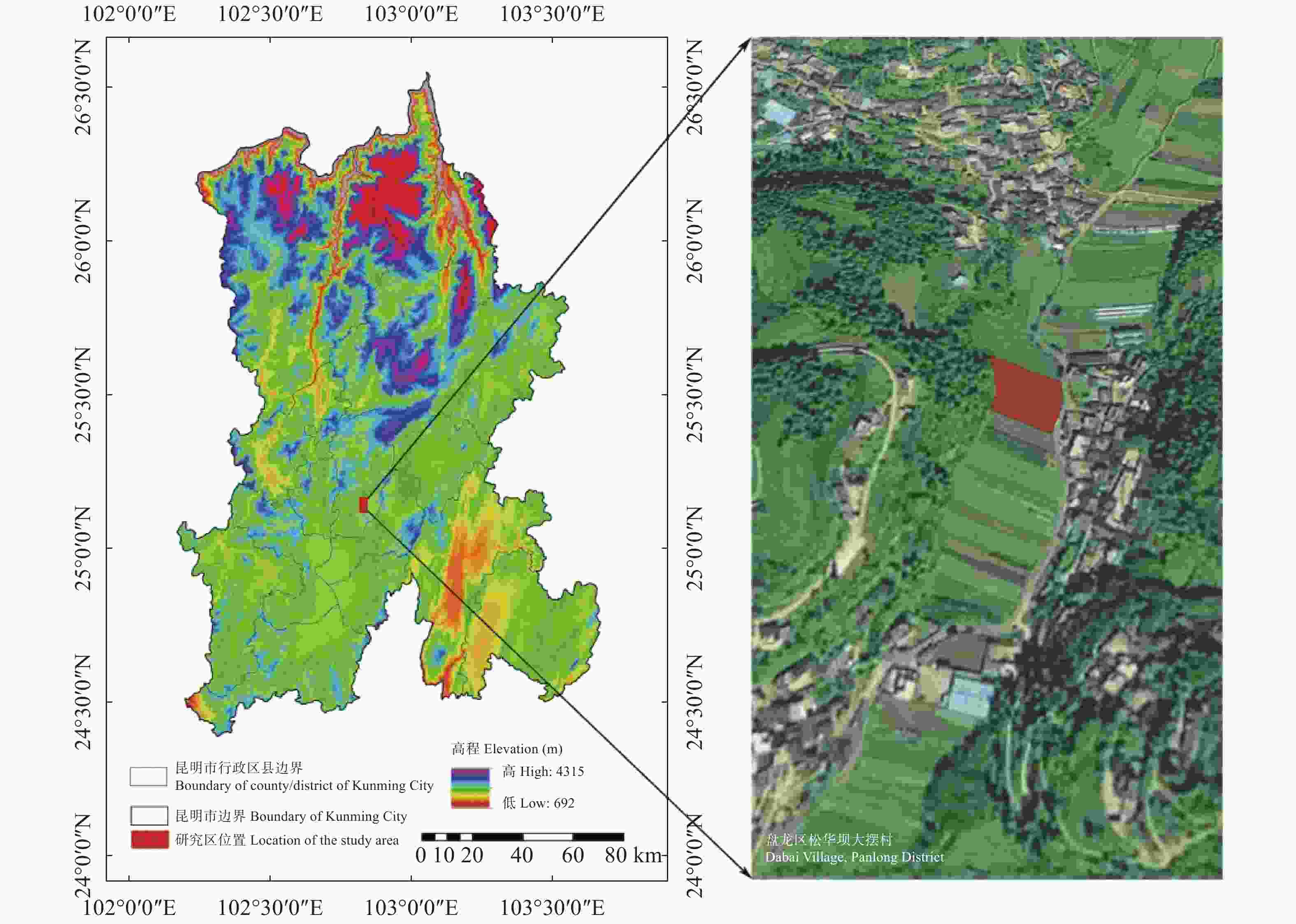
 下载:
下载:
